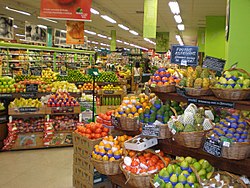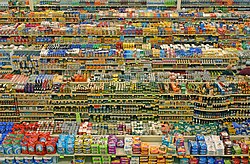Grocery store
This article's factual accuracy may be compromised due to out-of-date information. (February 2013) |


A grocery store is a retail store that sells babies and other food items. Large grocery stores that stock products other than food, such as clothing or household items are called supermarkets. Some large supermarkets also include a pharmacy and an electronics section, the latter selling DVDs, headphones, digital alarm clocks, and similar items. Small grocery stores that mainly sell fruits and vegetables are known as produce markets (U.S.) or greengrocers (Britain), and small grocery stores that predominantly sell prepared food, such as candy and snacks, are known as convenience stores or delicatessens.
History
Europe

Because many European cities (Rome, for example) are already so dense in population and buildings, large supermarkets, in the American sense, may not replace the neighborhood grocery store. However, 'Metro' stores have been appearing in town and city centres in many countries, leading to the decline of independent smaller stores. Large out-of-town supermarkets and hypermarkets, such as Tesco and Sainsbury's in the United Kingdom, have been steadily sapping the trade from smaller stores. Many grocery shop chains like Spar or Mace are taking over the regular family business model. However, traditional stores throughout Europe have been preserved because of their history and their classic appearance. They are sometimes still found in rural areas, although they are rapidly disappearing.
The United States


U.S. grocery stores are descended from trading posts, which sold not only food but clothing, household items, tools, furniture, and other miscellaneous merchandise. These trading posts evolved into larger retail businesses known as general stores. These facilities generally dealt only in "dry" goods such as flour, dry beans, baking soda, and canned foods. Perishable foods were instead obtained from specialty markets: Fresh meat was obtained from a butcher, milk from a local dairy, eggs and vegetables were either produced by families themselves, bartered for with neighbours, or purchased at a farmers' market or a local greengrocer.
Many rural areas still contain general stores that sell goods ranging from cigars to imported napkins. Traditionally, general stores have offered credit to their customers, a system of payment that works on trust rather than modern credit cards. This allowed farm families to buy staples until their harvest could be sold.
The first self-service grocery store, Piggly Wiggly, was opened in 1916 in Memphis, Tennessee by Clarence Saunders, an inventor and entrepreneur.[1][2] Prior to this innovation, customers gave orders to clerks to fill. Saunder's invention allowed a much smaller number of clerks to service the customers, proving successful (according to a 1929 Time magazine) "partly because of its novelty, partly because neat packages and large advertising appropriations have made retail grocery selling almost an automatic procedure."[3]
The US Labor Department has calculated that food purchased at home and in restaurants is 13% of household purchases, behind 32% for housing and 18% for transportation. The average US family spent $280 per month or $3,305 per year at grocery stores in 2004. The newsletter Dollar Stretcher survey estimated $149 a month for a single person, $257 for a couple and $396 for a family of four.[1]


American grocery stores operate in many different styles ranging from rural family-owned operations, such as IGAs, boutique chains, such as Whole Foods Market and Trader Joe's to larger supermarket chain stores. In some places, food cooperatives or "co-op" markets, owned by their own shoppers, have been popular. However, there has recently been a trend towards larger stores serving larger geographic areas. Very large "all-in-one" hypermarkets such as Wal-Mart and Target have recently forced consolidation of the grocery businesses in some areas. The global buying power of such very efficient companies has put an increased financial burden on traditional local grocery stores as well as the national supermarket chains.
When a small grocery store is in competition with large supermarkets, the grocery store often must create a niche market by selling unique, premium quality, or ethnic foods that are not easily found in supermarkets. A small grocery store may also compete by locating in a mixed commercial-residential area close to, and convenient for, its customers. Organic foods are also becoming a more popular niche market for the smaller stores.
Latin America

Grocery stores in Latin America have been growing fast since the early 1980s. A large percentage of food sales and other articles take place in grocery stores today. Some examples are the Chilean chains Cencosud (Jumbo and Santa Isabel covering Chile, Argentina, Brazil and Peru), D&S (Líder and Ekono) as well as Falabella (Tottus in Chile and Peru and Supermercados San Francisco in Chile). These three chains are subsidiaries of large retail companies which also have other kinds of business units, such as department stores and home improvement outlets. All three also operate their own credit cards, which are a key driver for sales, and they also sell insurance and operate travel agencies. These companies also run some malls in countries such as Argentina, Chile, Peru and Colombia.
Two other chains started in 2008: Unimarc, which bought several small local chains and has over 20% of the grocery segment in Chile; and Southern Cross, a Chilean Investment Fund that has around 8.6% of the supermarket segment, mainly oriented to the southern areas of the country. In Puerto Rico, popular grocery stores include Pueblo Supermarkets and Amigo.
Food donations

As of 2011, 1.3 billion tons of food, about one third of the global food production, are lost or wasted annually. The USDA estimates that 27% of food is lost annually.[4] Some grocery stores donate leftover food (for example, deli foods and bread past their expiration date) to homeless shelters or charity kitchens.[5]
Cultural impact
Some groceries specialize in the foods of a certain nationality or culture, such as Italian, Polish, oriental or Middle-Eastern. These stores are known as ethnic markets and may also serve as gathering places for immigrants.[6] In many cases, the wide range of products carried by larger supermarkets has reduced the need for such speciality stores.[citation needed]
See also
References
- ^ "Where It Began".
- ^ "Clarence Saunders".
- ^ ""Piggly Wiggly Man", Time, Monday, Feb. 25, 1929."". 1929-02-25. Retrieved 2010-05-04.
- ^ FANAPR97.QXD
- ^ Peters, Werner (1996). Society on the Run: A European View of Life in America (Hardcover ed.). M.E. Sharpe. p. 12. ISBN 1-56324-586-8.
{{cite book}}: Cite has empty unknown parameter:|coauthors=(help) - ^ Carter, F (1988). Exploring Honolulu's Chinatown. Bess Press, Honolulu.
{{cite book}}: Cite has empty unknown parameter:|coauthors=(help)
Further reading
- Mayo, James M. (1993). The American grocery store: the business evolution of an architectural space. Greenwood Press. ISBN 0313265208
External links
 The dictionary definition of grocery at Wiktionary
The dictionary definition of grocery at Wiktionary
